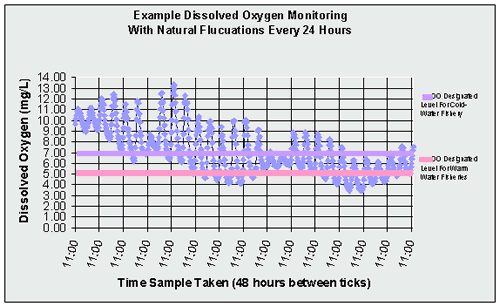Lower Grand Watershed Interactive Tool (WIT) - Depressed Dissolved Oxygen


Depressed dissolved oxygen occurs when the oxygen dissolved in water and readily available to aquatic organisms drops below optimal levels.
Dissolved oxygen (DO), reported in units of milligrams of gas per liter of water (mg/L), refers to the volume of oxygen gas in the water. DO can be depleted through respiration, decay of organic matter, and direct chemical oxidation (Brown, 1985). Aeration and photosynthesis are the main sources of DO in stream water. Because oxygen concentrations are usually greater in air than in water, oxygen molecules will dissolve into the water due to this difference in concentration. Furthermore, by producing waves, wind serves to create more surface area for oxygen molecules to saturate producing further diffusion of oxygen molecules. Aquatic plants also introduce oxygen as a byproduct of photosynthesis, the process by which plants produce their own food.
Because oxygen is produced during photosynthesis and consumed during respiration and decomposition, daily (diurnal) DO fluctuations result. Photosynthesis, which requires light, occurs only during daylight hours, while respiration and decomposition occur 24 hours a day. Consequently, DO concentrations decline throughout the night reaching its lowest point before dawn, when photosynthesis begins. It is at dawn that fish are most susceptible to stress due to DO depletion. Seasonal variations, like diurnal variations, also affect DO concentrations. Winter months may experience lower DO levels, even though colder water holds more DO. Ice cover or increased decomposition of oxygen-demanding organic material from the previous growing season result in lower DO levels.
Other physical processes affecting DO concentrations are temperature and pollution. Because temperature has an inverse relationship with gas solubility, warmer water will hold less gas than colder water. Summertime fish kills can result if water temperatures become too warm increasing the stress placed on fish. Furthermore, pollution from human activities may lead to unnatural decreases in DO concentrations. When large inputs of sewage or urban and agricultural runoff are introduced into the stream, microorganisms will decompose this organic matter and consume greater amounts of oxygen.
Click here to view a figure on dilution and decay of degradable, oxygen-demanding wastes and heat.
For more information, download a DEQ Biochemical Oxygen Demand (BOD) factsheet.
Source: "Depending on flow rates and the amount of pollutants, streams recover from oxygen-demanding wastes and heat if they are given enough time and are not overloaded." Miller, G. Tyler Jr. 2001. Environmental Science 8th Edition. Brooks/Cole, Canada. pg 30.
